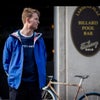UEFA Elite Stadium
Estadio Santiago Bernabéu is a football stadium in the Chamartín district of Madrid, Spain. It was inaugurated on 14 December 1947 and is owned by Real Madrid C.F. With a current capacity of 80,354 spectators, it was named as a UEFA Elite stadium in 2007.
El Bernabéu, named after chairman Santiago Bernabéu Yeste, is one of the world's most famous and prestigious football venues. It hosted the European Cup final three times, in 1957, 1969 and 1980, and is scheduled to host the UEFA Champions League 2010 final. The finals for the 1964 European Nations' Cup and the 1982 World Cup have also been held at the Bernabéu.
On 22 June 1944, the Industrial and Commercial Bank granted a credit to Santiago Bernabéu and Rafael Salgado for writing the land adjacent to the old Chamartín Stadium. On 5 September 1944, were elected as Palace of Fine Arts Circle layout architects Manuel Muñoz Monasterio y Luis Alemany Soler and the structure that gave way to the stadium. On 27 October 1944, the construction works on the stadium began.
The Estadio Santiago Bernabéu was officially inaugurated on 14 December 1947 with a match between Real Madrid FC and Os Belenenses of Portugal under the name of the Nuevo Estadio Chamartín. The venue had a capacity of 75,145 spectators, 27,645 of which have seats (7,125 covered) and 47,500 for standing fans (2,000 seats). Sabino Barinaga was the first player who advanced to the whites.
The first major renovation occurred in 1954. 19 June of that year opened the extension of the lateral so the stadium could accommodate 125,000 spectators. Thus, the Madrid coliseum became the biggest field of all the participants of the newly established European Cup, which is why the other clubs thanked the gesture of Real Madrid of sharing a locker, as fans filled the field with white assiduously.
On 4 January 1955, after the General Assembly of Members Compromisaros, it was decided that the state adopt the present name in honour of the club president and architect of the stadium, Santiago Bernabéu.
In May 1957, Real Madrid opened the electric lightning in a game against Sport Recife of Brazil.
The next big change was not until the early 1980s with the hosting of the 1982 FIFA World Cup in Spain. The stadium had to adapt to the changing times and with this, architects Rafael Luis Alemany and Manuel Salinas were hired to renovate. The brothers were sons of Luis Alemany Alemany Soler, who carried out the construction site next to Munoz Monasterio. The work lasted 16 months and had a cost of 704 million pesetas, of which 530 million was paid by the city of Madrid.
The improvements included a number of points. First, FIFA forced two-thirds of the seating area to be covered. For this reason, Real Madrid installed a canopy covering the perimeter of the first and second amphitheater area, except the east side. Thus, the stadium's capacity was reduced from 120,000 to 90,800 spectators, 24,550 of which were covered by the new roof. It also remodeled the façade, installed new electronic funds in the north and south ends as well as renovating the press areas, lockers rooms, access, and ancillary areas.
The stadium hosted four matches in the World Cup: three second-round Group 2 matches (West Germany vs. England, West Germany vs. Spain, and Spain vs. England) and the final between Italy and West Germany.
In the mid 1980s, UEFA introduced new safety standards due to increased violence in the stadiums of Europe. Therefore, The stadium was forced to create separate shortcuts to different localities and seats for all spectators. The need to compensate for the loss of towns to villages by foot seating made at the beginning of the 1990s, the Santiago Bernabéu went through a large expansion and remodeling. The board of Ramón Mendoza ordered the project to Gines Navarro Construcciones, S.A.
The work started on 7 February 1992 and concluded on 7 May 1994 with a final cost of more than pts5 billion, substantially raising the debt of the club, having no institutional support.
The work concluded with the creation of an amphitheater on the west side and in the funds, coupled with the existing building by imposing high modulus by hydraulic jacks.
In total, 20,200 improvements were installed, including each seat having a tilt of 87 degrees, ensuring a perfect view and closeness to the pitch. In addition, to access the new ring, four entrance towers were erected on the outside, each with two staircases and a central spiral ramp.
With the new structure, the height of the stadium was increased from 22 to 45 metres so that, during the winter, two-thirds of the field of play left in the shade and lawn deterioration. For this reason, a polypropylene pipe network was installed at a 20cm depth over 30km long with the purpose of circulating hot water, disallowing the turf to freeze in cold temperature.
Also, due to the height of the stand, it was necessary to improve and increase the power of lighting and a retractable protective cover was installed to protect the viewers from the elements. After the renovation, the stadium's capacity was at a whopping 110,000 spectators.
Already in the summer of 1998, and chaired by Lorenzo Sanz, the Santiago Bernabéu adapted to seat all of its locations, bringing its capacity down to 75,328 spectators.
When Florentino Pérez became the president of Real Madrid, he launched a "master plan" with one goal: To improve the comfort of the Santiago Bernabéu and the quality of its facilities, and maximise revenue for the stadium.
Pérez invested €127 million in five years (2001–2006) by adding an expansion to the east side of the stadium, as well adding a new façade on Father Damien, new costumes, new boxes and VIP areas, a new stage in honour of the east side, a new press area (also located on the east side), a new audio system, new bars, placement of heat in the stands, panoramic lifts, new restaurants, escalators in the towers access, and implementation of the multipurpose building in the street Father Damien.
Following the enlargement of the lateral east side and the creation of new galleries, the capacity of the Santiago Bernabéu is 80,354, all seated.
In 2007, the 1,000th game was played at the Santiago Bernabéu. In addition, the latest revision of UEFA on 27 October 2007, on the occasion of Champions League match against Olympiacos, served as a final step to give the Santiago Bernabéu elite stadium status on 14 November 2007, a month before the celebration of the 60th anniversary of the inauguration of the stadium. UEFA announced that the club will officially rename the Elite stadium.
Pérez proposed construction of a retractable roof before he resigned in 2005. In 2009, following the re-election of Pérez as the club president, it was announced that the roof construction was looking unlikely due to the financial situation of the club. However, according to Spanish sports newspaper Marca, Pérez wants to restructure Santiago Bernabéu. According to the newspaper, the architect in charge will be chosen between a shortlist of Spanish architects Santiago Calatrava and Pritzker Prize-winner Rafael Moneo, and Chinese-American Ieoh Ming Pei, also a Pritzker winner.
The stadium was officially announced the venue for the 2010 UEFA Champions League Final in a star studded ceremony in Nyon in 2008.
The Estadio Santiago Bernabéu is located in the Paseo de la Castellana, in the Chamartín district. It occupies the block bounded by the Paseo de la Castellana and the streets of Concha Espina, Padre Damián, and Rafael Salgado.
The stadium has its own Madrid Metro station along the 10 line called Santiago Bernabéu.





